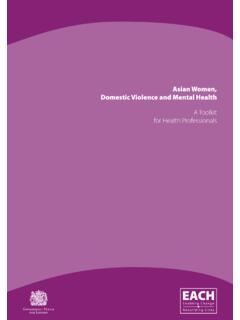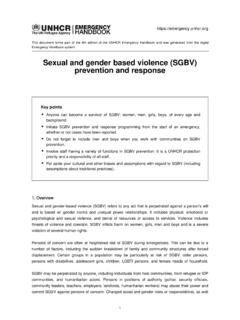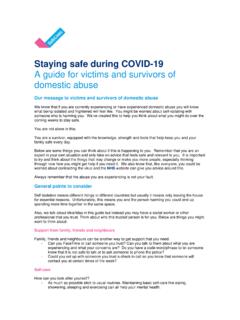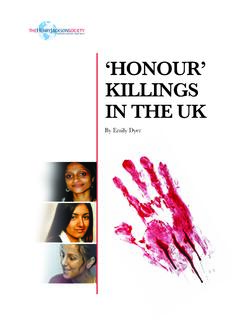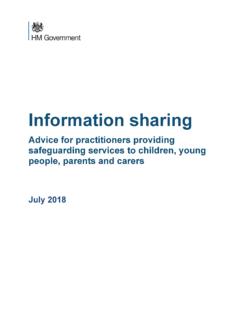Transcription of STRUCTURAL VIOLENCE - UNICEF
1 STRUCTURAL VIOLENCEAGAINST CHILDREN INSOUTH ASIA UNICEF ROSA 2018 Cover Photo:Bangladesh, Jamalpur: Children and other community members watching an anti-child marriage drama performed by members of an Adolescent Club. UNICEF /South Asia 2016/BronsteinThe material in this report has been commissioned by the United Nations Children s Fund ( UNICEF ) regional office in South Asia. UNICEF accepts no responsibility for errors. The designations in this work do not imply an opinion on the legal status of any country or territory, or of its authorities, or the delimitation of frontiers. Permission to copy, disseminate or otherwise use information from this publication is granted so long as appropriate acknowledgement is given. The suggested citation is: United Nations Children s Fund, STRUCTURAL VIOLENCE against Children in South Asia, UNICEF , Kathmandu, VIOLENCEAGAINST CHILDREN INSOUTH ASIAACKNOWLEDGEMENTSUNICEF would like to acknowledge Drs.
2 Taveeshi Guptan with Fiona Samuels for their work in developing this report. The report was prepared under the guidance of Kendra Gregson with Sheeba Harma of the United Nations Children's Fund Regional Office in South Asia. This report benefited from the contribution of a distinguished reference group: Susan Bissell of the Global Partnership to End VIOLENCE against Children, Ingrid Fitzgerald of United Nations Population Fund Asia and the Pacific region, Shireen Jejeebhoy of the Population Council, Ali Parveen from the University of Sheffield, Ramya Subrahmanian of Know VIOLENCE in Childhood, and Enakshi Ganguly Thukral of HAQ (Centre for Child Rights India). From UNICEF , staff members representing the fields of child protection, gender and research, provided important inputs informed by specific South Asia country contexts, programming and current VIOLENCE research.
3 In particular, from UNICEF we would like to thank: Ann Rosemary Arnott, Roshni Basu, Ramiz Behbudov, Sarah Coleman, Shreyasi Jha, Aniruddha Kulkarni, Mary Catherine Maternowska and Eri Mathers 1 EXECUTIVE SUMMARY 21 INTRODUCTION Objective and aims Methodology 92 CONCEPTUAL FRAMEWORK What is STRUCTURAL VIOLENCE ? Social-ecological framework and STRUCTURAL VIOLENCE 113 STRUCTURES ARE NOT NEUTRAL: UNPACKING STRUCTURAL VIOLENCE IN SOUTH ASIA Socio-cultural systems 15 Norms around the ideal girl and the ideal boy 18 Maintaining honour and ijjat/izzat 19 Kinship rules 24 Devaluing girls and women 26 Understandings of parenting 29 Socialization of discriminatory norms 32 Acceptability of VIOLENCE 33 Ease of exploitation of children Economic systems 36 Son preference 37 Child marriage 38 Dowry-related VIOLENCE 40 domestic VIOLENCE 40 Physical, emotional, and sexual VIOLENCE 41 Child labour 43 Trafficking 46 Children with disabilities Fragile institutions 49 VIOLENCE against girls and women 49 Physical, emotional.
4 And sexual abuse at home and in schools 51 Child labour 52 Child soldiers Impact of STRUCTURAL VIOLENCE on psycho-social and mental health 5464 INSTITUTIONAL RESPONSE TO STRUCTURAL VIOLENCE Prevention Response 59 Laws and policies 60 Governance 64 Health services 675 CONCLUSIONS 70 BIBLIOGRAPHY 73 ANNEX: METHODOLOGY 84 LIST OF TABLE, BOXES & FIGURET able 1 Availability of legal provisions and policies for child protection in South Asia 60 Box 1 Analysis of media and honour-based VIOLENCE : Case study from Pakistan 20 Box 2 Chhaupadi and goth pratha in Nepal: Value of purity and cleanliness as STRUCTURAL VIOLENCE 23 Box 3 Cultural variations in markers for transitioning to adulthood 26 Box 4 Bangladesh s sex-selected abortion rates 37 Box 5 ICT use as a medium for VIOLENCE against children and adolescents 43 Box 6 Nationalism as an emerging form of VIOLENCE 52 Box 7 Good practice example from India.
5 An anti-trafficking network 59 Box 8 Good practice of an inclusive child protection act in Bhutan 61 Box 9 Women and child-friendly desks in Bhutan, Nepal and Sri Lanka 65 Figure 1 Understanding STRUCTURAL VIOLENCE using a socio-ecological framework 131 STRUCTURAL VIOLENCEAGAINST CHILDREN INSOUTH ASIAACRONYMSAIDS Acquired Immune Deficiency SyndromeAWON Action Works Nepal DHS Demographic and Health SurveyFGM/C Female Genital Mutilation/CuttingHIV Human Immunodeficiency VirusICT Information and Communication TechnologyILO International Labour OrganizationIMAGES International Men and Gender Equality SurveyIPV Intimate Partner ViolenceLGBT Lesbian, Gay, Bisexual, TransgenderLTTE Liberation Tigers of Tamil EelamNGO Non-Governmental OrganizationP4P Partners for PreventionRMG Ready-Made GarmentSAIEVAC South Asia Initiative to End VIOLENCE Against ChildrenSC Scheduled CasteST Scheduled TribeUNICEF United Nations Children s FundWCD Women and Child DeskWCSC Women and Children Service CentreWHO World Health OrganizationSince the 2006 UN Global Study on VIOLENCE against Children, scholars, practitioners and programme implementers have made strong efforts to understand VIOLENCE against children using an inter-disciplinary lens.
6 What is emerging now is a gap in knowledge on the determinants of the risk factors underlying VIOLENCE that is, the invisible and indirect factors that in the global literature are known as STRUCTURAL VIOLENCE . This review was carried out to describe the state of research on STRUCTURAL VIOLENCE and its relationship with interpersonal VIOLENCE . STRUCTURAL VIOLENCE is understood as patterns of differences within large-scale social structures differences of power, wealth, privilege, education and health that are unjust and unequal. This form of VIOLENCE also occurs in a society if institutions and policies are designed in a way that creates barriers or inequitable access to a range of goods and services for some people but not others. Overall, as a result of STRUCTURAL VIOLENCE , people experience extreme social oppression and, consequently, erosion of human dignity and of all associated dimensions, including confidence, overall well-being and security.
7 KEY FINDINGS The literature indicates that there are five types of STRUCTURAL VIOLENCE prevalent across the South Asia region that underlie all forms of interpersonal VIOLENCE reviewed. These can be EXECUTIVE SUMMARY understood through a socio-cultural, economic systems, and fragile institutions lens. Gender-based STRUCTURAL VIOLENCE STRUCTURAL VIOLENCE owing to gender reveals itself through unequal hierarchies between men and women, characteristic of patriarchal societies. Using a socio-cultural lens, norms around an ideal girl or boy, maintaining family honour, kinship rules, socialization of discriminatory norms, devaluing of girls and women and acceptability of VIOLENCE all play a role in creating conditions that increase the chances of children facing interpersonal VIOLENCE . Inequality, discrimination, exploitation and forced choice are themes that permeate children and adolescents lives.
8 Inequality manifests in VIOLENCE such as child marriage , domestic VIOLENCE and honour-based killings, since girls are defined by their relationships to the men in their lives and unequally bear the burden of upholding the family s honour. Boys face inequality since their experiences of abuse are often dismissed and considered less traumatic than girl s. For all children, modelling of gender-typed behaviours at home reinforces the cycle of discriminatory norms. Girls and boys who see household chores as gender-segregated are also expected to follow the pattern that adults do: girls spend more time in unpaid labour at home than boys, who spend more time in paid labour. 3 STRUCTURAL VIOLENCEAGAINST CHILDREN INSOUTH ASIA Using an economics lens, gender-based STRUCTURAL VIOLENCE manifests as son preference and dowry-related VIOLENCE , given that the economic worth of a girl is tied to how much dowry she brings whereas the worth of a boy is tied to how much dowry can be demanded.
9 Additionally, lack of employment opportunities, intersecting with social norms that restrict girls movement and freedom, ensures financial independence remains unattainable for most girls, often paving the way either to marriage or to dangerous work such as domestic servitude or the sex trade. Moreover, socio-cultural and economic systems overlap such that the systemic devaluing of girls and women as individuals with their own rights creates a context where women are seen as commodities. Owning women and their bodies is crucial to having control over honour. Fragile institutions further place children at risk, with girls and women facing severe sexual abuse during times of conflict. Boys often experience pressure to seek work, given the high chance of fathers being absent owing to war-related death or STRUCTURAL VIOLENCE Socio-culturally, age-based STRUCTURAL VIOLENCE in the region is a result of cultural definitions of what it means to be a child and of what it means to be a parent.
10 Often, justification for child maltreatment ( physical and emotional abuse) stems from the perceived role of a parent as a disciplinarian and the need for children to learn culturally defined correct ways to behave. Perpetrators of sexual VIOLENCE against children believe children are unable to resist, more easily deceived, less likely to report abuse and more willing to go along with abuse than adults. While economic necessities often dictate interpersonal forms of VIOLENCE such as child labour, cultural expectations around the importance of contributing to household income, as well as the belief that children are easily exploitable, ensure children face something known as forced choice that is, a choice limited to two alternatives, an either/or choice, with those who have more power favoured in any setting. In Sri Lanka, heavy migration to the Middle East has led to an increase in demand for domestic servants, with children increasingly sought out as they are willing to work for less money and have fewer demands (related to lodgings, amount of food, etc.)










